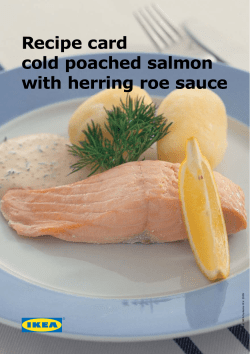
polychlorinated biphenyls (pcbs)
POLYCHLORINATEDBIPHENYLS (PCBS) The BC Salmon Farmers Association has received questions about the levels of PCB’s and contaminants in farm-raised salmon and the food chain in general. Unfortunately, there is a lot of misinformation in the public sphere about PCBs and about PCBs in farm-raised salmon. In an effort to address those concerns we have put together this information sheet. The bottom line: farm-raised salmon is a healthy, nutritious source of lean protein and is safe to eat. What are polychlorinated biphenyls (PCBs)? Polychlorinated biphenyls, or PCBs, are chemicals that were used primarily in the first half of the last century. PCBs have been shown to cause environmental toxicity and, in high enough doses, can be hazardous to human health. The production of PCBs was banned by the United States in 1979 and by the Stockholm Convention on Persistent Organic Pollutants in 2001. Although PCBs are still present in many of our daily meal choices, all these foods remain safe to eat, and neither the US FDA nor Health Canada recommends any consumption limits on any foods because of dioxins or PCBsi. How are they in our food? PCBs are classified as a persistent organic pollutant (POP). POPs are organic compounds that take a long time to degrade and therefore persist in the environment. Because of this, POPs, including PCBs have contaminated the entire food chain. At high enough levels, PCBs bioaccumulate, meaning they accumulate in an animal’s body faster than they can be eliminated. What are safe levels? The Canadian Food Inspection Agency tests animal feed for numerous chemicals and contaminants, including PCBs. Fish meal, fish oil and complete fish feeds are tested to ensure the safety of the feed used for farm-raised salmonii. Differences between Species: Many comparisons have been made between farm-raised and wild salmon PCB levels. However, different salmon species have different fat contents. Since PCBs are stored in fat, that means species with different levels of fattiness will have different PCB levels. In order to do a fair comparison of PCB levels in salmon, you should compare wild and farm-raised of the same species; wild Atlantic vs farm-raised Atlantic, for example. POLYCHLORINATEDBIPHENYLS (PCBS) Direct comparison of farm-raised and wild salmon: Concerns have been raised about the PCB levels in farm-raised salmon based on one highlypublicized study that came out in 2004. Since this time, many more studies have been done which show PCB levels in farm-raised salmon are well within safe limits. As well, major advancements have been made in fish feed composition which has lowered the level of PCBs in farm-raised salmon. A report by the World Health Organization in 2010 looked at the risks and benefits of fish consumption, including the issue of PCB and other contaminants. It found that levels of dioxins and dioxin-like compounds (PCBs) in farm-raised and wild Atlantic salmon are very close. It should also be noted that the levels of EPA and DHA (Omega-3 fatty acids) are much higher in farm-raised salmon. Source: Joint FAO/WHO Expert Consultation on the Risks and Benefits of Fish Consumption; Appendix A iii levels If you ate farm-raised salmon two or three times a week, you would still be far below the set for dioxin exposure set by the Joint FAO/WHO Expert Committee on Food Additives . This report also concluded that the benefits of regularly eating oily fish such as salmon far outweigh any potential risks. POLYCHLORINATEDBIPHENYLS (PCBS) How does farm-raised salmon compare to other foods? PCB levels in farm-raised Atlantic salmon are lower than many other foods most people consume on a regular basis. Source: http://www.aquaculture.ca/files/health-salmon.php All of these foods are safe to eat, and neither the US FDA nor Health Canada recommends any consumption limits on any foods because of dioxins or PCBs. i Health Canada PCBs Fact Sheet CFIA National Feed Inspection Programs - Monitoring Sampling Activity – Dioxins, Furans, and Polychlorinated Biphenyls (PCBs) iii Joint FAO/WHO Expert Consultation on the Risks and Benefits of Fish Consumption, table 2 ii
© Copyright 2025











